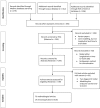Bayesian joint modelling of longitudinal and time to event data: a methodological review
- PMID: 32336264
- PMCID: PMC7183597
- DOI: 10.1186/s12874-020-00976-2
Bayesian joint modelling of longitudinal and time to event data: a methodological review
Abstract
Background: In clinical research, there is an increasing interest in joint modelling of longitudinal and time-to-event data, since it reduces bias in parameter estimation and increases the efficiency of statistical inference. Inference and prediction from frequentist approaches of joint models have been extensively reviewed, and due to the recent popularity of data-driven Bayesian approaches, a review on current Bayesian estimation of joint model is useful to draw recommendations for future researches.
Methods: We have undertaken a comprehensive review on Bayesian univariate and multivariate joint models. We focused on type of outcomes, model assumptions, association structure, estimation algorithm, dynamic prediction and software implementation.
Results: A total of 89 articles have been identified, consisting of 75 methodological and 14 applied articles. The most common approach to model the longitudinal and time-to-event outcomes jointly included linear mixed effect models with proportional hazards. A random effect association structure was generally used for linking the two sub-models. Markov Chain Monte Carlo (MCMC) algorithms were commonly used (93% articles) to estimate the model parameters. Only six articles were primarily focused on dynamic predictions for longitudinal or event-time outcomes.
Conclusion: Methodologies for a wide variety of data types have been proposed; however the research is limited if the association between the two outcomes changes over time, and there is also lack of methods to determine the association structure in the absence of clinical background knowledge. Joint modelling has been proved to be beneficial in producing more accurate dynamic prediction; however, there is a lack of sufficient tools to validate the prediction.
Keywords: Bayesian estimation; Dynamic prediction; Joint models; Longitudinal outcomes; Time-to-event.
Conflict of interest statement
The authors declare that they have no competing interests.
References
-
- Buta GB, Goshu AT, Worku HM. Bayesian joint modelling of disease progression marker and time to death event of HIV/AIDS patients under ART follow-up. Br J Med Med Res. 2015;5(8):1034–1043. doi: 10.9734/BJMMR/2015/12907. - DOI
-
- Erango MA, Goshu AT, Buta GB, Dessisoa AH. Bayesian joint modelling of survival of HIV/AIDS patients using accelerated failure time data and longitudinal CD4 cell counts. Br J Med Med Res. 2017;20(6):1–12. doi: 10.9734/BJMMR/2017/32123. - DOI
-
- Dessiso AH, Goshu AT. Bayesian joint modelling of longitudinal and survival data of HIV/AIDS patients: a case study at bale robe general hospital, Ethiopia. Am J Theor Appl Stat. 2017;6(4):182–190. doi: 10.11648/j.ajtas.20170604.13. - DOI
-
- Serrat C, Rué M, Armero C, Piulachs X, Perpiñán H, Forte A, et al. Frequentist and Bayesian approaches for a joint model for prostate cancer risk and longitudinal prostate-specific antigen data. J Appl Stat. 2015;42(6):1223–1239. doi: 10.1080/02664763.2014.999032. - DOI
Publication types
MeSH terms
Grants and funding
LinkOut - more resources
Full Text Sources


